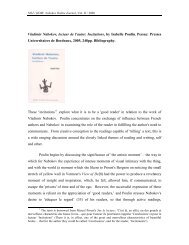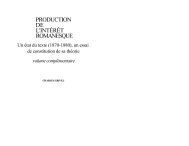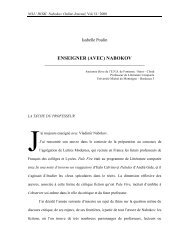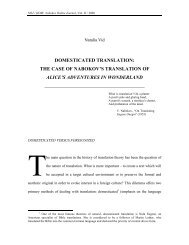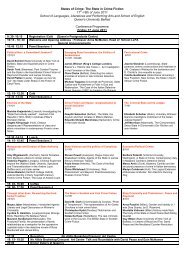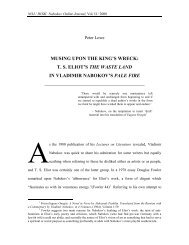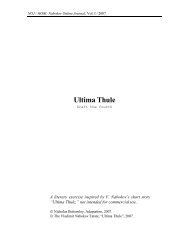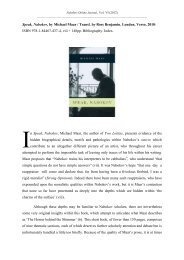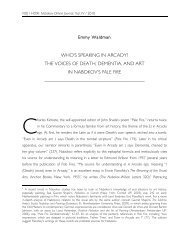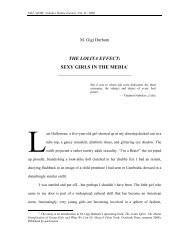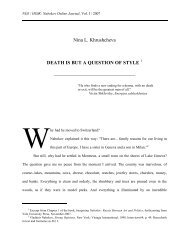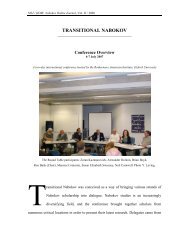You also want an ePaper? Increase the reach of your titles
YUMPU automatically turns print PDFs into web optimized ePapers that Google loves.
Nabokov Online Journal, Vol. V (2011)<br />
_______________________________________________________________________<br />
and its relationship to crime and law, left the parameters of strictly literary debate and<br />
revealed extratextual consequences. 7<br />
PARODY, PECCANCY, AND PECCADILLO IN LOLITA<br />
In Nabokov’s Lolita, questions of parody, crime, and aesthetic value are curiously<br />
entangled. Numerous critics have discussed the meta-literary character of the novel. 8<br />
Some have noted that despite Nabokov’s own emphasis on aesthetic bliss as the only<br />
ultimate purpose of his creative work, the novel is by no means devoid of ethical<br />
considerations, thematizing and exploring as it does the relationship between the ethical<br />
and the aesthetic. One of the ways to approach this relationship in Nabokov is to suggest,<br />
as does Richard Rorty in “The Barber of Kasbeam: Nabokov on Cruelty,” that in his<br />
novels Nabokov explores his fear of cruelty by probing the capacity of art to overcome it.<br />
Examining Humbert’s cruel incuriosity, specifically in the episode in which the<br />
eponymous barber tells the uninterested Humbert about his dead son, Rorty argues that<br />
Nabokov exorcises his fear that art might not necessarily involve empathy by creating<br />
aloof artists whose autonomy/originality precludes compassion (148). A similar argument<br />
is made by David Rampton, who in his study of Lolita states that “Humbert’s description<br />
of Lolita at tennis is an exercise in the special art of seeing her as an object, an art that<br />
only aesthetic detachment makes possible. And his ‘Confession,’ the product of that<br />
detachment, is at the same time a study of its limitations” (116). In conjunction with these<br />
interpretations, a key observation of Ellen Pifer – that “[c]areful attention to the text [of<br />
Lolita] reveals the ways in which it is designed to reveal what the narrator attempts to<br />
conceal, or blindly ignores” (187) – might suggest that Humbert, while deficient as a<br />
7 Approaching the issue from a legalistic point of view, a recent article by David Roh “Two Copyright Case<br />
Studies from a Literary Perspective” argues the opposite. In my opinion the consequence of Nabokov’s<br />
very public lawsuit and no less emphatic foreword is a broadening of the boundaries of the literary<br />
dialogue; David Roh, however, reads the copyright dispute, despite Pera’s ostensible victory, as a potential<br />
agent of suppression in the process of literary evolution. Such highly publicized cases of copyright<br />
disputes, Roh asserts, will make publishers avoid appropriative works, thereby squelching potentially<br />
fruitful literary and ideological debates.<br />
8 On Nabokov’s parodic method and aims in Lolita, see the studies of, among others, Alfred Appel, Jr.,<br />
Thomas R. Frosch, Brian Walter, and Julia Bader.<br />
5



